作為(wei) 一位推理迷,Fonda老師樂(le) 於(yu) 在課餘(yu) 時間閱讀各個(ge) 年代與(yu) 風格的推理小說,也樂(le) 於(yu) 在讀到推理小說中的生物元素時發文與(yu) 大家分享,討論。
22年的暑假,Fonda老師向大家推薦了日本推理小說家市川憂人的作品《藍玫瑰不會(hui) 安眠》,裏麵向大家簡單探討了基因怎樣編碼蛋白質,以及怎樣通過基因編輯或者人工育種的方法培育出新的物種。
而最近,老師又在同為(wei) 日本推理小說家知念實希人(同時也是日本內(nei) 科學會(hui) 認定醫生)寫(xie) 的一本名為(wei) 《玻璃塔謎案》的小說中看到了以遺傳(chuan) 密碼(genetic code)作為(wei) 解謎線索的謎麵。
《玻璃塔謎案》官方簡介: 一座玻璃塔在雪地深處的森林中閃閃發光。地上十一層,地下一層,它是一個(ge) 美麗(li) 而巨大的尖頂塔。在熱愛推理小說的館主的邀請下,刑警、醫生、小說家、編輯、名偵(zhen) 探等各具特色的嘉賓聚集到玻璃塔中。當晚,館主預定發表重大消息,但在那之前卻在密室裏被殺了。第二天,玻璃塔因附近山上的雪崩而關(guan) 閉了交通和通信。被困在塔裏的人們(men) ,等待警察的幫助,卻接二連三地發生了密室殺人事件。此外,還有人用血寫(xie) 下了十三年前的一件疑案。名偵(zhen) 探碧月夜和醫生一條遊馬追查著謎團……
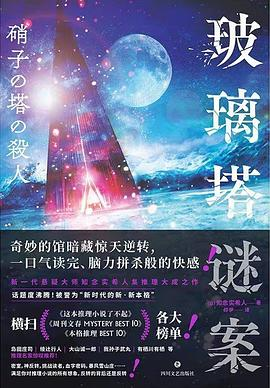
接下來就讓我們(men) 一起來挑戰解謎吧!
“屍體(ti) 上放著一張A4打印紙,匕首穿過紙張刺進胸口,將紙固定在那裏”--摘自《玻璃塔謎案》
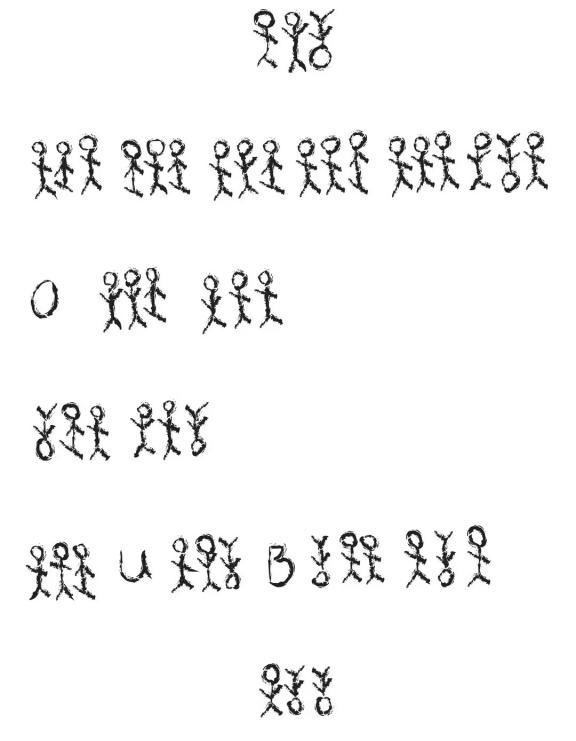
解謎不需要小說中的內(nei) 容為(wei) 依據,根據老師前麵關(guan) 於(yu) 遺傳(chuan) 密碼的提示,你是否已經有了線索呢? 前方有謎底,如果你更想在故事裏找到答案,歡迎點擊左上角退出,去體(ti) 驗作者一手構造的玻璃尖塔哦。 如果你已經解開謎團,或者隻想盡快知道謎底,請往下翻,解謎前倒數防劇透...
3...
2....
你確定你不去書(shu) 中找答案嗎?...
1..... !
謎底:由於(yu) 書(shu) 中故事與(yu) DNA有聯係,DNA是遺傳(chuan) 物質,而小人謎語中,小人每三個(ge) 人為(wei) 一組,讓人聯想到每三個(ge) 堿基(base)為(wei) 一組的遺傳(chuan) 密碼;而用於(yu) 組成謎語的小人共有四種,正好對應了核酸(nucleic acid) 上的四種堿基,A,T/U,C,G。
由於(yu) 謎語的最上方以及最下方各有一組三聯密碼子(triplet code) ,可以聯想到它們(men) 分別代表起始密碼子( start codon)與(yu) 終止密碼子(stop codon), 故可以對比出四種小人各自代表的堿基種類,如圖一所示。
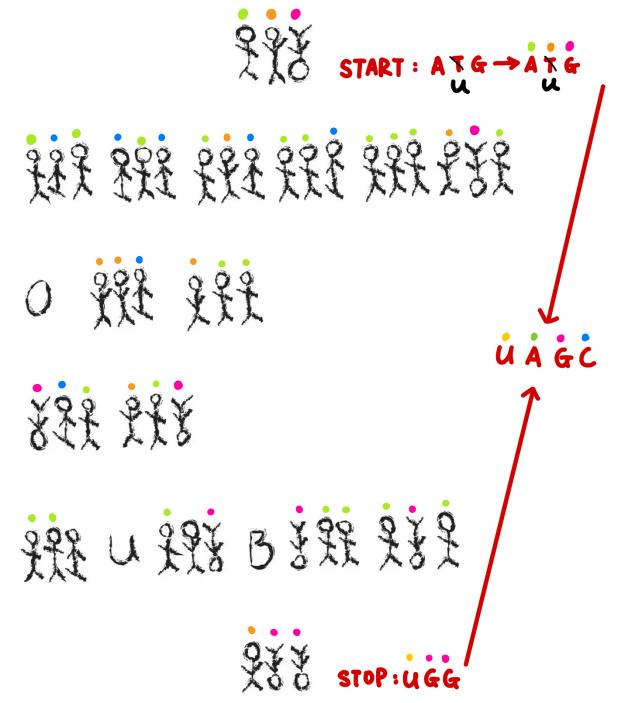
圖一
不過在重現解謎的過程中,老師發現書(shu) 中貌似有個(ge) bug,即作者在謎底中是以DNA的序列標注的,然而在對照密碼表時用的卻是RNA所對應的密碼表(注:mRNA和DNA的base sequence是互補的,而不是一樣的,所以對應的是不一樣的密碼表,如:在DNA上,ATT對應的是一個(ge) 終止信號,而體(ti) 現在RNA上,則是UAA對應該終止信號。),太尷尬了,讓Fonda老師多花了半個(ge) 小時重新改圖,返工...因此,老師在後文的圖片與(yu) 講解中統一將密碼改為(wei) RNA密碼子(codon)(圖二)。
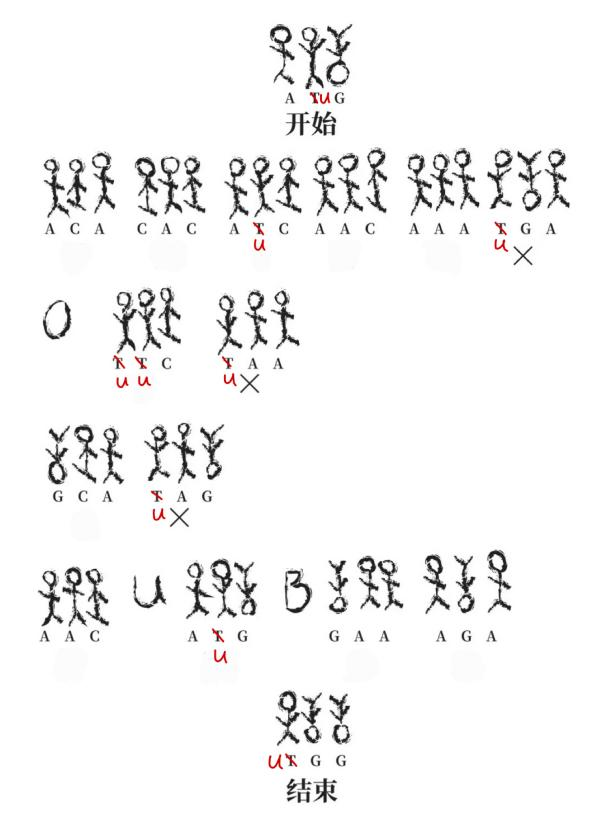
圖二:標出每組小人對應的RNA密碼子(codon)
接著,我們(men) 再根據密碼表將condon轉化為(wei) 每種氨基酸的種類,在每組小人的下方標出。這裏老師附上的是來源百度百科的中文對照表(圖三),而不是我們(men) 教科書(shu) 附錄中的表格,原因是書(shu) 中的表格用的是三字母縮寫(xie) 來表示氨基酸名稱,而解謎用的是氨基酸的單字母符號。
雖然大多數氨基酸的首字母與(yu) 單字母縮寫(xie) 一致,但某些撞了首字母的氨基酸則需要采用其它字母:如AAA所對應的氨基酸是lysine,三字母縮寫(xie) 為(wei) Lys,而單字母表示為(wei) K。
如此,信息之間的轉化方式則為(wei) 【一組小人】→【一種氨基酸】→【一個(ge) 字母】,而將這些字母串聯起來,我們(men) 就能得到一組有意義(yi) 的短語啦,其為(wei) “think of a number”(圖四),這是一本書(shu) 的名字,而這本書(shu) 中隱藏了主角所需要的下一個(ge) 關(guan) 鍵信息。
(左為(wei) 圖三,右為(wei) 圖四,點擊圖片放大查看)
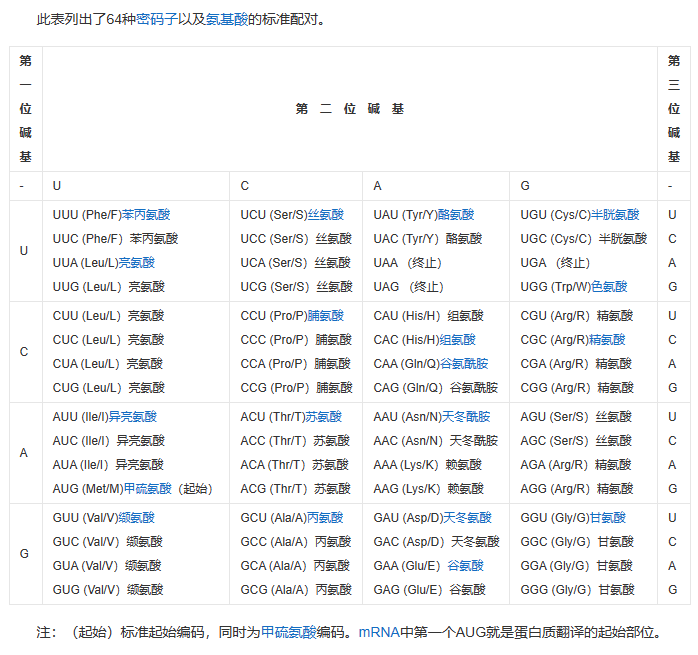
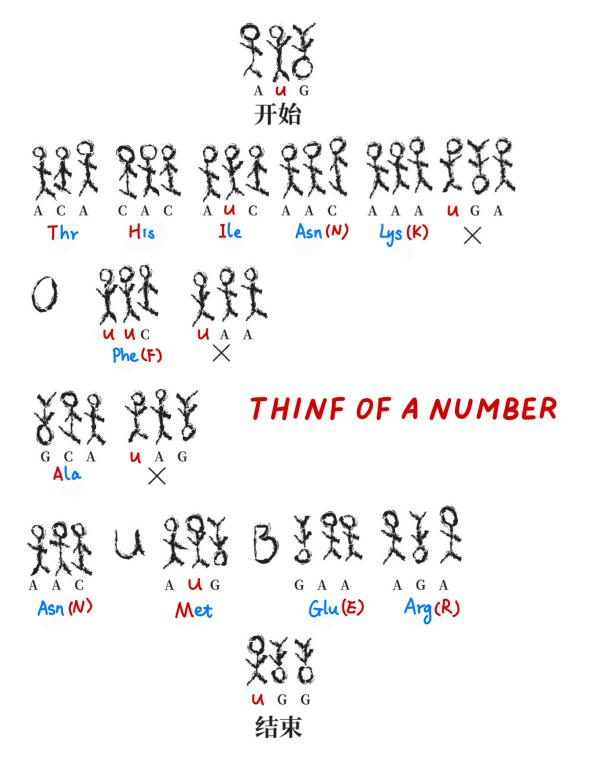
以上就是作者用生物知識給大家耍的一個(ge) 小把戲啦,老師看到評論中有文科生叫苦不迭呢,你覺得如何呢,你給這個(ge) 謎麵打幾分,你是否也覺得這個(ge) 謎麵對文科生不公平呢?都說蘿卜青菜各有所愛,歡迎在評論區說出你的看法哦。
如果正在備考AS的你發現對這個(ge) 解答聽得雲(yun) 裏霧裏,那麽(me) 我們(men) 得加緊複習(xi) 第六單元了哦!
此外,值得一提的是,該謎麵改編自1905年出版的《福爾摩斯歸來記》的一個(ge) 短篇《跳舞的小人》,感興(xing) 趣的同學們(men) 也可以去溯源哦。
最後附上Nature Education 網站對於(yu) GENETIC CODE 的定義(yi) : “The genetic code is a set of rules defining how the four-letter code of DNA is translated into the 20-letter code of amino acids, which are the building blocks of proteins. The genetic code is a set of three-letter combinations of nucleotides called codons, each of which corresponds to a specific amino acid or stop signal. The concept of codons was first described by Francis Crick and his colleagues in 1961. During the same year, Marshall Nirenberg and Heinrich Matthaei performed experiments that began deciphering the genetic code. They showed that the RNA sequence UUU specifically coded for the amino acid phenylalanine. Following this discovery, Nirenberg, Philip Leder, and Gobind Khorana identified the rest of the genetic code and fully described each three-letter codon and its corresponding amino acid. There are 64 possible permutations, or combinations, of three-letter nucleotide sequences that can be made from the four nucleotides. Of these 64 codons, 61 represent amino acids, and three are stop signals. Although each codon is specific for only one amino acid (or one stop signal), the genetic code is described as degenerate, or redundant, because a single amino acid may be coded for by more than one codon. It is also important to note that the genetic code does not overlap, meaning that each nucleotide is part of only one codon-a single nucleotide cannot be part of two adjacent codons. Furthermore, the genetic code is nearly universal, with only rare variations reported. For instance, mitochondria have an alternative genetic code with slight variations.” -- genetic code | Learn Science at Scitable (nature.com)





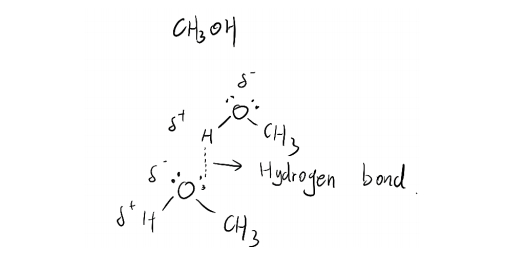









評論已經被關(guan) 閉。